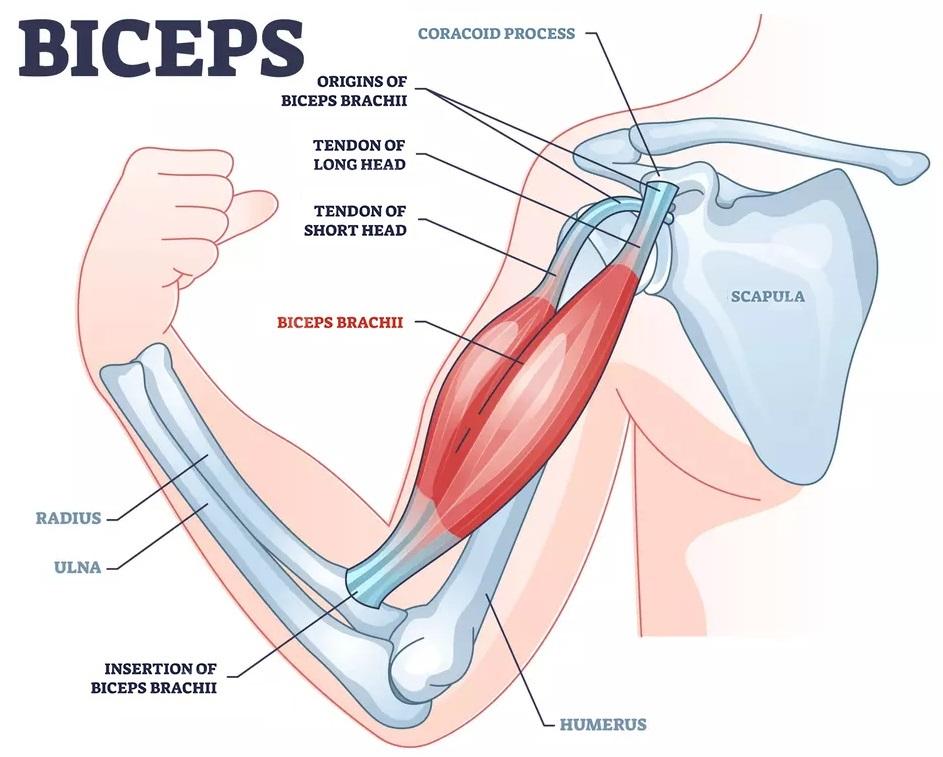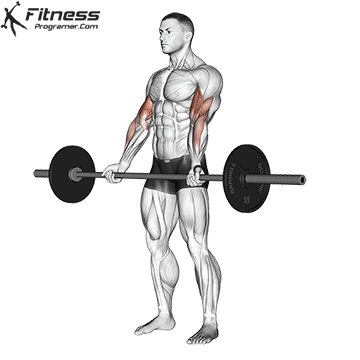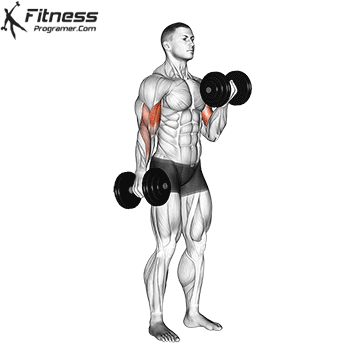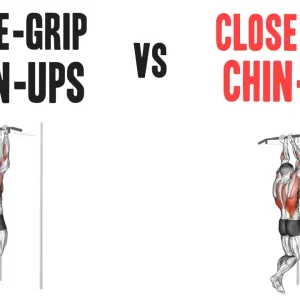Contents
When it comes to arm training, few debates are more common than this: Should you use barbells or dumbbells for curls? Both tools are staples in hypertrophy programs, but they offer different mechanical and muscular advantages.
This article breaks down:
- Biceps anatomy and function
- Muscle recruitment differences
- Strength and hypertrophy potential
- Pros and cons of barbell and dumbbell curls
- Training recommendations based on goals
Biceps Anatomy: A Brief Overview
The biceps brachii muscle is composed of two distinct heads:
- The long head, which originates from the supraglenoid tubercle of the scapula and contributes to the outer biceps peak.
- The short head, which originates from the coracoid process of the scapula and sits on the inner side of the arm.

Both heads converge to insert at the radial tuberosity of the forearm, and together they function primarily to:
- Flex the elbow joint, bringing the forearm toward the upper arm.
- Supinate the forearm, rotating the palm upward.
- Assist in shoulder flexion, though this role is secondary.
Effective biceps training requires exercises that load the elbow through a full range of motion and ideally include some component of supination, as this engages both heads maximally.
What Are Barbell Curls?
Barbell curls are a bilateral exercise where both arms work together to lift a barbell from full elbow extension to elbow flexion, typically using a shoulder-width supinated grip. This movement is commonly performed with a straight bar or an EZ-curl bar, depending on wrist comfort and individual mobility.

Advantages of Barbell Curls
One of the most notable advantages of barbell curls is that they allow for relatively heavier loads due to bilateral assistance and mechanical efficiency. Because both arms contribute to moving the bar simultaneously, lifters can generally overload the biceps more effectively. Barbell curls also promote more consistent technique across repetitions due to the fixed hand position, which minimizes variability in range of motion and tempo.
This makes the barbell curl particularly beneficial for building foundational strength and for programming progressive overload—a key driver of hypertrophy and performance adaptation.
Limitations of Barbell Curls
The primary limitation of barbell curls is the restriction imposed by a fixed grip, which can exacerbate discomfort in the wrists and elbows, especially for individuals with limited forearm mobility. Additionally, barbell curls can conceal muscular imbalances between the left and right arms, potentially reinforcing asymmetries if not addressed elsewhere in training.
What Are Dumbbell Curls?
Dumbbell curls are performed using a single dumbbell in each hand, allowing each arm to move independently through the curling motion. Unlike barbell curls, dumbbell curls can accommodate a variety of wrist positions, including supinated, neutral (hammer grip), and rotating supination, offering more variation in targeting different components of the biceps and forearm musculature.

Advantages of Dumbbell Curls
Dumbbell curls allow for a more natural and individualized movement path, which makes them a more joint-friendly option for most lifters. The ability to rotate the wrist throughout the range of motion (as seen in supinating curls) enables enhanced activation of the biceps brachii, particularly the short head. Dumbbells also help address muscular imbalances, as each arm works independently and must manage its own load.
This makes dumbbell curls especially beneficial for those seeking symmetry in arm development, as well as individuals recovering from injury or correcting unilateral deficiencies.
Limitations of Dumbbell Curls
While dumbbells offer superior control and customization, they also typically limit the total amount of weight that can be lifted. This can be a drawback for strength-focused lifters looking to maximize overload. Additionally, because each arm must stabilize its own weight, the movement may become more technically demanding as fatigue sets in, increasing the risk of form breakdown.
Muscle Recruitment and Activation Differences
The muscle activation patterns of barbell and dumbbell curls have been analyzed in various electromyographic (EMG) studies. Research shows that barbell curls tend to produce higher levels of peak tension, largely due to the heavier load that can be lifted with both arms working together. In contrast, dumbbell curls may engage more stabilizing musculature and provide greater activation throughout the full range of motion, particularly when incorporating wrist rotation.
A key distinction lies in the ability to supinate. Dumbbells allow for active forearm rotation, which enhances activation of the short head of the biceps and the brachialis—muscles important for elbow flexion but often under-stimulated by fixed-grip barbell movements.
Range of Motion and Joint Comfort
When performed correctly, dumbbell curls generally offer a more complete range of motion than barbell curls. This is because each arm can travel through a path that suits the lifter’s individual joint structure and mobility. Barbell curls, especially with a straight bar, often limit wrist rotation and can lead to discomfort or strain in the elbows or forearms, particularly in lifters with limited flexibility.
For this reason, many athletes choose to use an EZ-curl bar, which allows for a semi-supinated grip and tends to be more comfortable for long-term training.
Symmetry and Unilateral Development
Dumbbell curls have a clear advantage when it comes to developing symmetrical arms. Because each side must lift its own load independently, dumbbells prevent the dominant side from compensating for the weaker one, a common issue with barbell movements. This makes dumbbell curls especially valuable during rehabilitation, post-injury training, or in hypertrophy phases focused on muscle balance and aesthetics.
Hypertrophy and Strength Potential
When comparing the potential for muscle hypertrophy, both exercises can be highly effective when used correctly. Barbell curls are better suited for lifting heavier loads and applying progressive overload, which is crucial for building maximum strength and stimulating type II muscle fibers.
Dumbbell curls, on the other hand, are ideal for creating greater internal tension, improving the quality of contraction, and targeting the biceps with more control. Because of their versatility, dumbbells also allow for more advanced training techniques, such as alternating curls, Zottman curls, and incline curls, all of which contribute to well-rounded muscle development.
Programming Recommendations
The best approach to biceps training typically involves incorporating both barbell and dumbbell variations. This ensures that the lifter benefits from the loading potential of the barbell and the unilateral control and flexibility of the dumbbell.
Sample Weekly Training Plan
| Exercise | Sets x Reps |
|---|---|
| Barbell Curl | 3 × 8–10 |
| Dumbbell Curl | 3 × 10–12 per arm |
| Hammer Curl (Dumbbell) | 3 × 12–15 per arm |
This structure enables you to train the biceps across different rep ranges and with varying time-under-tension strategies, optimizing both neural and hypertrophic adaptation.
Learn how to train arms with supersets for even more progress.
Conclusion
Both barbell and dumbbell curls play valuable roles in a well-structured resistance training program. Barbell curls are ideal for those seeking to build strength and lift heavier loads with a consistent bilateral movement pattern. Dumbbell curls, by contrast, offer enhanced muscular balance, greater freedom of movement, and improved activation of the biceps through a longer and more customizable range of motion.
To maximize both muscle size and joint health, most lifters will benefit from alternating or combining these two exercise modalities across different training phases. By understanding their unique advantages and applying them with intention, you can enhance your arm development and prevent common training plateaus.
References
- Schoenfeld BJ. (2010). The mechanisms of muscle hypertrophy and their application to resistance training. Journal of Strength and Conditioning Research.
- Signorile JF, et al. (2002). Electromyographic analysis of muscle activity during traditional and modified dumbbell curls. Journal of Strength and Conditioning Research.
- Oliveira LF, et al. (2009). EMG analysis of biceps brachii in different curl exercises. Journal of Sports Science and Medicine.
- Saeterbakken AH, et al. (2020). Effects of different biceps curl variations on muscle activation and strength performance. PeerJ.
- Wakahara T, et al. (2012). Muscle hypertrophy patterns and regional muscle activation due to exercise selection. European Journal of Applied Physiology.



